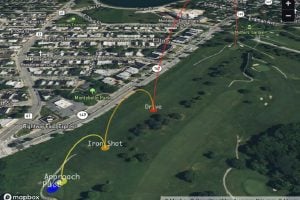
Chatbots can help you write an email, but can they improve your golf game? Two Johns Hopkins undergraduates think so. Amy Wang and Erica King have built a specialized analytics tool that lets golfers input their swing data and receive personalized feedback from a DeepSeek model trained on golf expertise. Members of the Johns Hopkins Sports Analytics Research Group, they presented their work in late April at this year’s Design Day, an annual event that showcases the innovative work of students in the Whiting School of Engineering.
Majoring in applied mathematics and statistics, King has been golfing for around a decade, while Wang, who’s double majoring in AMS and computer science, just started last summer. The two connected over wanting to find a tool to better understand and improve their swings.
“I proposed this project at the beginning of this school year to learn about the statistical intricacies of the various features of a golf swing,” King says. “Then Amy joined in to help build our dashboard and virtual coach.”
They analyzed downswing features such as club speed, ball speed, spin rate, and more to determine their order of importance, the optimal values a golfer should try for in each feature, and how they work in combination with each other.

Using this analysis, the pair built an interactive dashboard to provide not only specific technical feedback based on external or estimated measurements of a player’s swing, but also to answer golfers’ questions and make recommendations. Users can input data gathered from external tools like the TrackMan simulators at Golf Galaxy—or simply estimate their stats—to populate the dashboard’s “player data” page and receive personalized advice. The students also included a geospatial component that analyzes a player’s shot history on a golf course and recommends a custom ball path to aim for.
“Even if you’re not familiar with golf, you can play around with different values of downswing features on the dashboard and receive a predicted carry—or distance the ball will travel through the air—for your hypothetical shot,” says King.
At last month’s school-wide poster session, the pair invited attendees to do just that, encouraging them to play around with the dashboard to receive calculations, visualizations, and feedback on their swing input. And though Design Day may be over, the team is looking forward to working with entrepreneurs and other external groups to continue this project.